Solution to Epidemiology and Biostatistics Assignment 1 - HSH205
VerifiedAdded on 2023/04/20
|7
|1238
|153
Homework Assignment
AI Summary
This document presents a solution to an Epidemiology and Biostatistics assignment, addressing questions related to study design, measures of association, and disease frequency. The solution covers topics such as population sampling methods, response rates, and the calculation and interpretation of prevalence, incidence, and risk ratios. Specific calculations are provided for lung disease prevalence, cumulative incidence, and risk assessment in mobile phone usage and particulate matter exposure scenarios. The assignment also includes an analysis of cumulative incidence and incident rates for COPD, comparing the accuracy of different measurement methods. The document concludes with a bibliography referencing key resources in the field of epidemiology and biostatistics. Desklib provides this assignment as a study resource, offering students access to solved assignments and past papers to aid their learning.
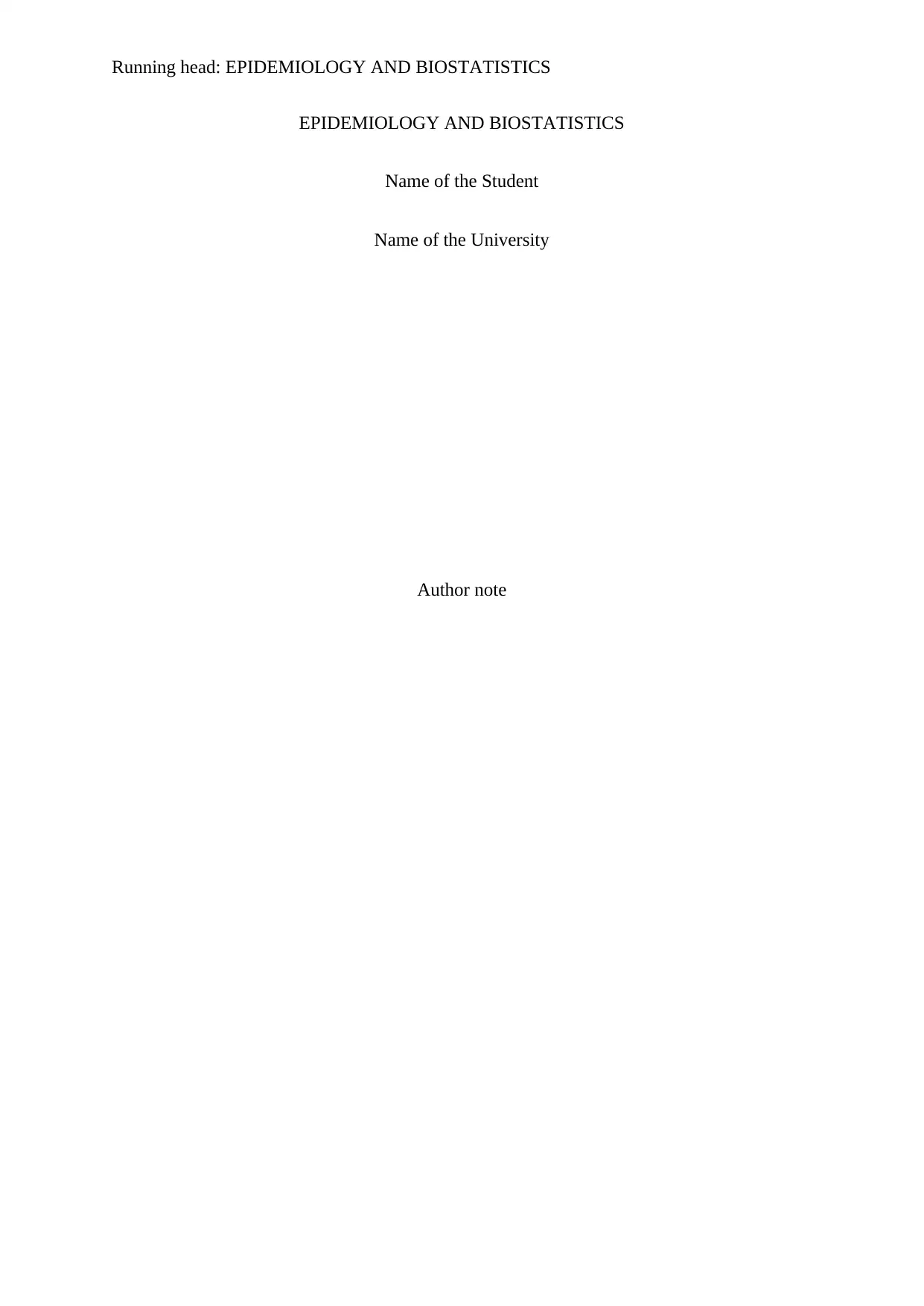
Running head: EPIDEMIOLOGY AND BIOSTATISTICS
EPIDEMIOLOGY AND BIOSTATISTICS
Name of the Student
Name of the University
Author note
EPIDEMIOLOGY AND BIOSTATISTICS
Name of the Student
Name of the University
Author note
Paraphrase This Document
Need a fresh take? Get an instant paraphrase of this document with our AI Paraphraser
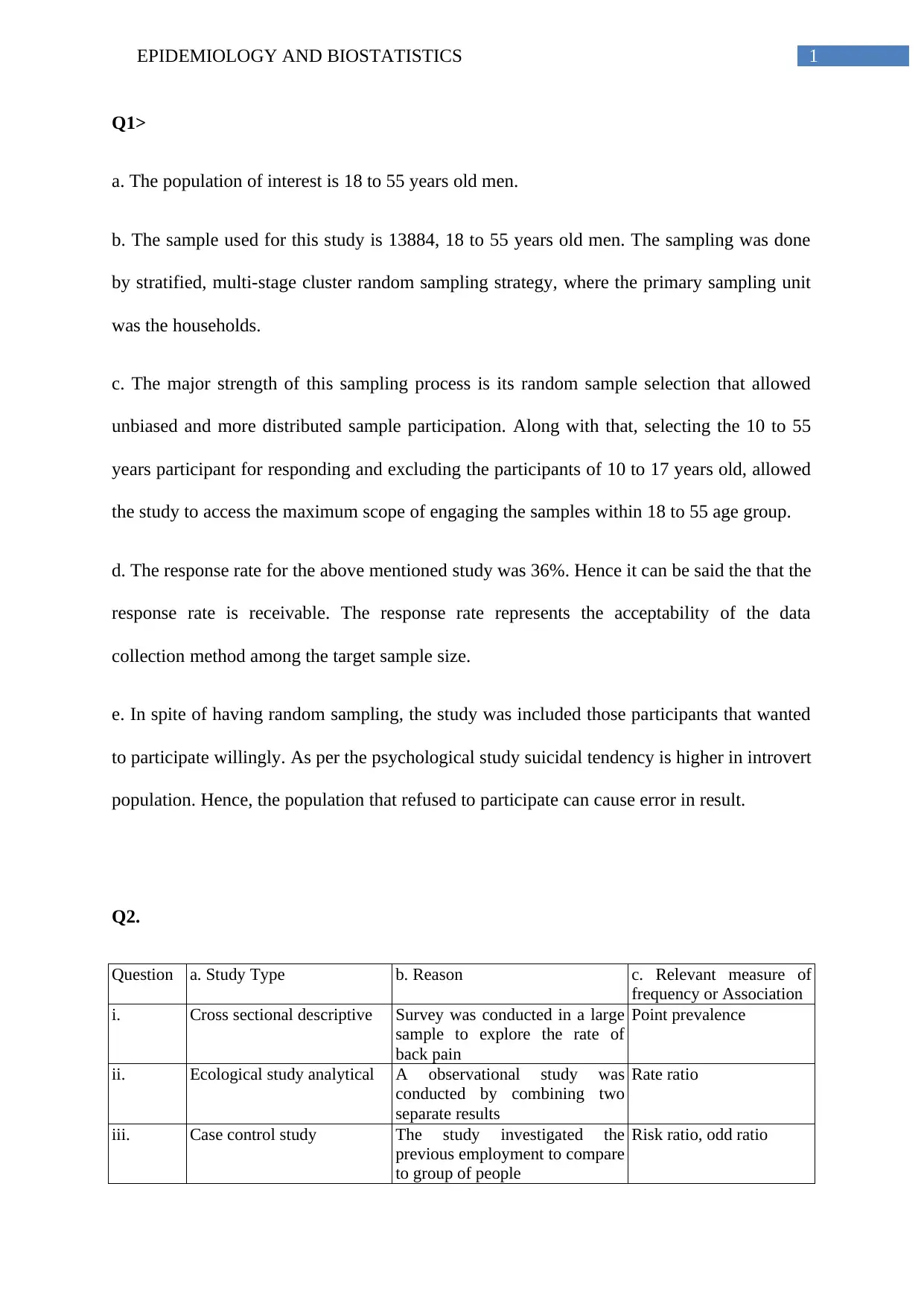
1EPIDEMIOLOGY AND BIOSTATISTICS
Q1>
a. The population of interest is 18 to 55 years old men.
b. The sample used for this study is 13884, 18 to 55 years old men. The sampling was done
by stratified, multi-stage cluster random sampling strategy, where the primary sampling unit
was the households.
c. The major strength of this sampling process is its random sample selection that allowed
unbiased and more distributed sample participation. Along with that, selecting the 10 to 55
years participant for responding and excluding the participants of 10 to 17 years old, allowed
the study to access the maximum scope of engaging the samples within 18 to 55 age group.
d. The response rate for the above mentioned study was 36%. Hence it can be said the that the
response rate is receivable. The response rate represents the acceptability of the data
collection method among the target sample size.
e. In spite of having random sampling, the study was included those participants that wanted
to participate willingly. As per the psychological study suicidal tendency is higher in introvert
population. Hence, the population that refused to participate can cause error in result.
Q2.
Question a. Study Type b. Reason c. Relevant measure of
frequency or Association
i. Cross sectional descriptive Survey was conducted in a large
sample to explore the rate of
back pain
Point prevalence
ii. Ecological study analytical A observational study was
conducted by combining two
separate results
Rate ratio
iii. Case control study The study investigated the
previous employment to compare
to group of people
Risk ratio, odd ratio
Q1>
a. The population of interest is 18 to 55 years old men.
b. The sample used for this study is 13884, 18 to 55 years old men. The sampling was done
by stratified, multi-stage cluster random sampling strategy, where the primary sampling unit
was the households.
c. The major strength of this sampling process is its random sample selection that allowed
unbiased and more distributed sample participation. Along with that, selecting the 10 to 55
years participant for responding and excluding the participants of 10 to 17 years old, allowed
the study to access the maximum scope of engaging the samples within 18 to 55 age group.
d. The response rate for the above mentioned study was 36%. Hence it can be said the that the
response rate is receivable. The response rate represents the acceptability of the data
collection method among the target sample size.
e. In spite of having random sampling, the study was included those participants that wanted
to participate willingly. As per the psychological study suicidal tendency is higher in introvert
population. Hence, the population that refused to participate can cause error in result.
Q2.
Question a. Study Type b. Reason c. Relevant measure of
frequency or Association
i. Cross sectional descriptive Survey was conducted in a large
sample to explore the rate of
back pain
Point prevalence
ii. Ecological study analytical A observational study was
conducted by combining two
separate results
Rate ratio
iii. Case control study The study investigated the
previous employment to compare
to group of people
Risk ratio, odd ratio

2EPIDEMIOLOGY AND BIOSTATISTICS
iv. Longitudinal study The study was conducted on a
particular sample to collect their
medical reports during 9 years
Period prevalence,
incident rate, cumulative
incident
v. Cross sectional analytical The sample was investigated to
analyse the hypothesis of
consuming sweeteners and
anxiety
Point prevalence,
prevalence ratio,
vi. Retrospective cohort study The study investigated the
previous association of exposed
and unexposed group
Risk ratio, odd ratio, rate
ratio
Q3.
Prevalence of lung disease at initial screening= (11/900)x100 = 1.222
a. The above prevalence of lung disease at initial screening 1.22 refers to the prevalence of
cases for each 100 people. However to convert this prevalence to case per 1000 person the
calculation is:
(1.222x100)/1000= 12.22
Hence, from the result it has been found the prevalence of lung disease at initial screening is
12.22 cases in 1000 population.
b. The number of workers at risk of developing lung disease at the start of the 10 year follow-
up study was (900-11) =889
c. For the cumulative incident, the disease free initial population was 889 and the new cases
during follow up 39.
Hence the cumulative incident for per 100 people = (39/889) x 100 = 4.38
Q4.
a. The most appropriate measures of association for this study type are risk ratio
b.
iv. Longitudinal study The study was conducted on a
particular sample to collect their
medical reports during 9 years
Period prevalence,
incident rate, cumulative
incident
v. Cross sectional analytical The sample was investigated to
analyse the hypothesis of
consuming sweeteners and
anxiety
Point prevalence,
prevalence ratio,
vi. Retrospective cohort study The study investigated the
previous association of exposed
and unexposed group
Risk ratio, odd ratio, rate
ratio
Q3.
Prevalence of lung disease at initial screening= (11/900)x100 = 1.222
a. The above prevalence of lung disease at initial screening 1.22 refers to the prevalence of
cases for each 100 people. However to convert this prevalence to case per 1000 person the
calculation is:
(1.222x100)/1000= 12.22
Hence, from the result it has been found the prevalence of lung disease at initial screening is
12.22 cases in 1000 population.
b. The number of workers at risk of developing lung disease at the start of the 10 year follow-
up study was (900-11) =889
c. For the cumulative incident, the disease free initial population was 889 and the new cases
during follow up 39.
Hence the cumulative incident for per 100 people = (39/889) x 100 = 4.38
Q4.
a. The most appropriate measures of association for this study type are risk ratio
b.
⊘ This is a preview!⊘
Do you want full access?
Subscribe today to unlock all pages.

Trusted by 1+ million students worldwide
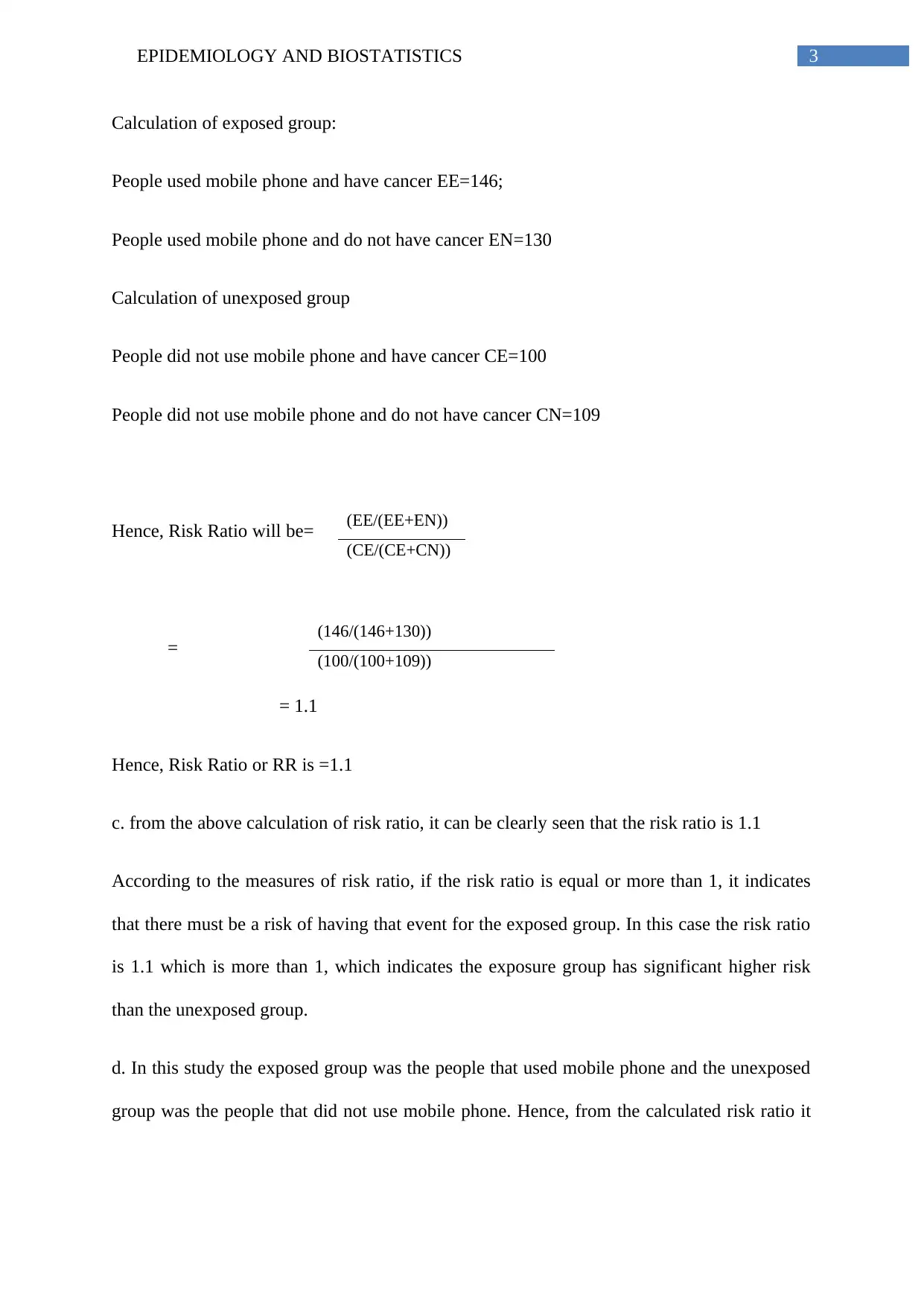
3EPIDEMIOLOGY AND BIOSTATISTICS
Calculation of exposed group:
People used mobile phone and have cancer EE=146;
People used mobile phone and do not have cancer EN=130
Calculation of unexposed group
People did not use mobile phone and have cancer CE=100
People did not use mobile phone and do not have cancer CN=109
Hence, Risk Ratio will be=
=
= 1.1
Hence, Risk Ratio or RR is =1.1
c. from the above calculation of risk ratio, it can be clearly seen that the risk ratio is 1.1
According to the measures of risk ratio, if the risk ratio is equal or more than 1, it indicates
that there must be a risk of having that event for the exposed group. In this case the risk ratio
is 1.1 which is more than 1, which indicates the exposure group has significant higher risk
than the unexposed group.
d. In this study the exposed group was the people that used mobile phone and the unexposed
group was the people that did not use mobile phone. Hence, from the calculated risk ratio it
(EE/(EE+EN))
(CE/(CE+CN))
(146/(146+130))
(100/(100+109))
Calculation of exposed group:
People used mobile phone and have cancer EE=146;
People used mobile phone and do not have cancer EN=130
Calculation of unexposed group
People did not use mobile phone and have cancer CE=100
People did not use mobile phone and do not have cancer CN=109
Hence, Risk Ratio will be=
=
= 1.1
Hence, Risk Ratio or RR is =1.1
c. from the above calculation of risk ratio, it can be clearly seen that the risk ratio is 1.1
According to the measures of risk ratio, if the risk ratio is equal or more than 1, it indicates
that there must be a risk of having that event for the exposed group. In this case the risk ratio
is 1.1 which is more than 1, which indicates the exposure group has significant higher risk
than the unexposed group.
d. In this study the exposed group was the people that used mobile phone and the unexposed
group was the people that did not use mobile phone. Hence, from the calculated risk ratio it
(EE/(EE+EN))
(CE/(CE+CN))
(146/(146+130))
(100/(100+109))
Paraphrase This Document
Need a fresh take? Get an instant paraphrase of this document with our AI Paraphraser
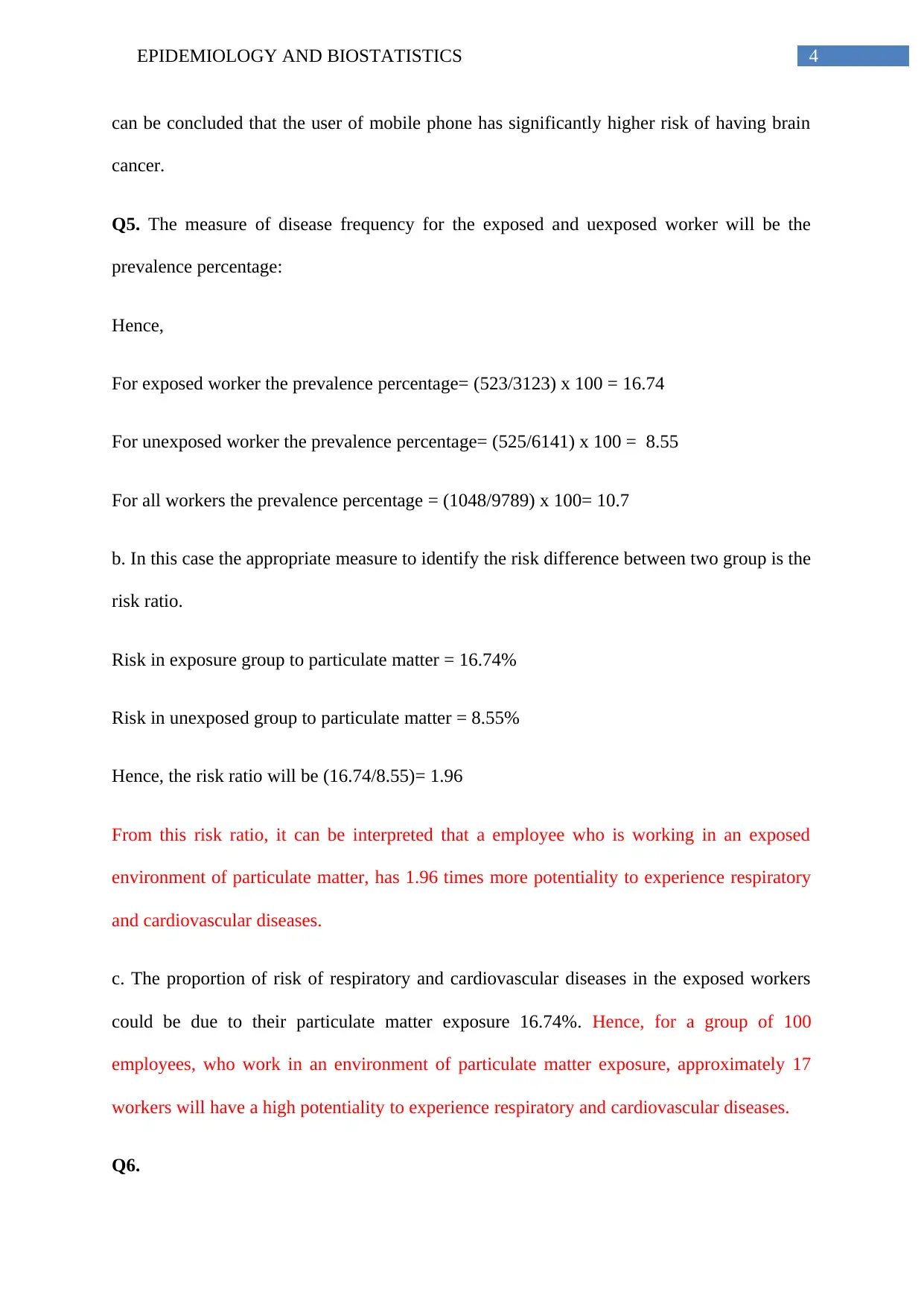
4EPIDEMIOLOGY AND BIOSTATISTICS
can be concluded that the user of mobile phone has significantly higher risk of having brain
cancer.
Q5. The measure of disease frequency for the exposed and uexposed worker will be the
prevalence percentage:
Hence,
For exposed worker the prevalence percentage= (523/3123) x 100 = 16.74
For unexposed worker the prevalence percentage= (525/6141) x 100 = 8.55
For all workers the prevalence percentage = (1048/9789) x 100= 10.7
b. In this case the appropriate measure to identify the risk difference between two group is the
risk ratio.
Risk in exposure group to particulate matter = 16.74%
Risk in unexposed group to particulate matter = 8.55%
Hence, the risk ratio will be (16.74/8.55)= 1.96
From this risk ratio, it can be interpreted that a employee who is working in an exposed
environment of particulate matter, has 1.96 times more potentiality to experience respiratory
and cardiovascular diseases.
c. The proportion of risk of respiratory and cardiovascular diseases in the exposed workers
could be due to their particulate matter exposure 16.74%. Hence, for a group of 100
employees, who work in an environment of particulate matter exposure, approximately 17
workers will have a high potentiality to experience respiratory and cardiovascular diseases.
Q6.
can be concluded that the user of mobile phone has significantly higher risk of having brain
cancer.
Q5. The measure of disease frequency for the exposed and uexposed worker will be the
prevalence percentage:
Hence,
For exposed worker the prevalence percentage= (523/3123) x 100 = 16.74
For unexposed worker the prevalence percentage= (525/6141) x 100 = 8.55
For all workers the prevalence percentage = (1048/9789) x 100= 10.7
b. In this case the appropriate measure to identify the risk difference between two group is the
risk ratio.
Risk in exposure group to particulate matter = 16.74%
Risk in unexposed group to particulate matter = 8.55%
Hence, the risk ratio will be (16.74/8.55)= 1.96
From this risk ratio, it can be interpreted that a employee who is working in an exposed
environment of particulate matter, has 1.96 times more potentiality to experience respiratory
and cardiovascular diseases.
c. The proportion of risk of respiratory and cardiovascular diseases in the exposed workers
could be due to their particulate matter exposure 16.74%. Hence, for a group of 100
employees, who work in an environment of particulate matter exposure, approximately 17
workers will have a high potentiality to experience respiratory and cardiovascular diseases.
Q6.
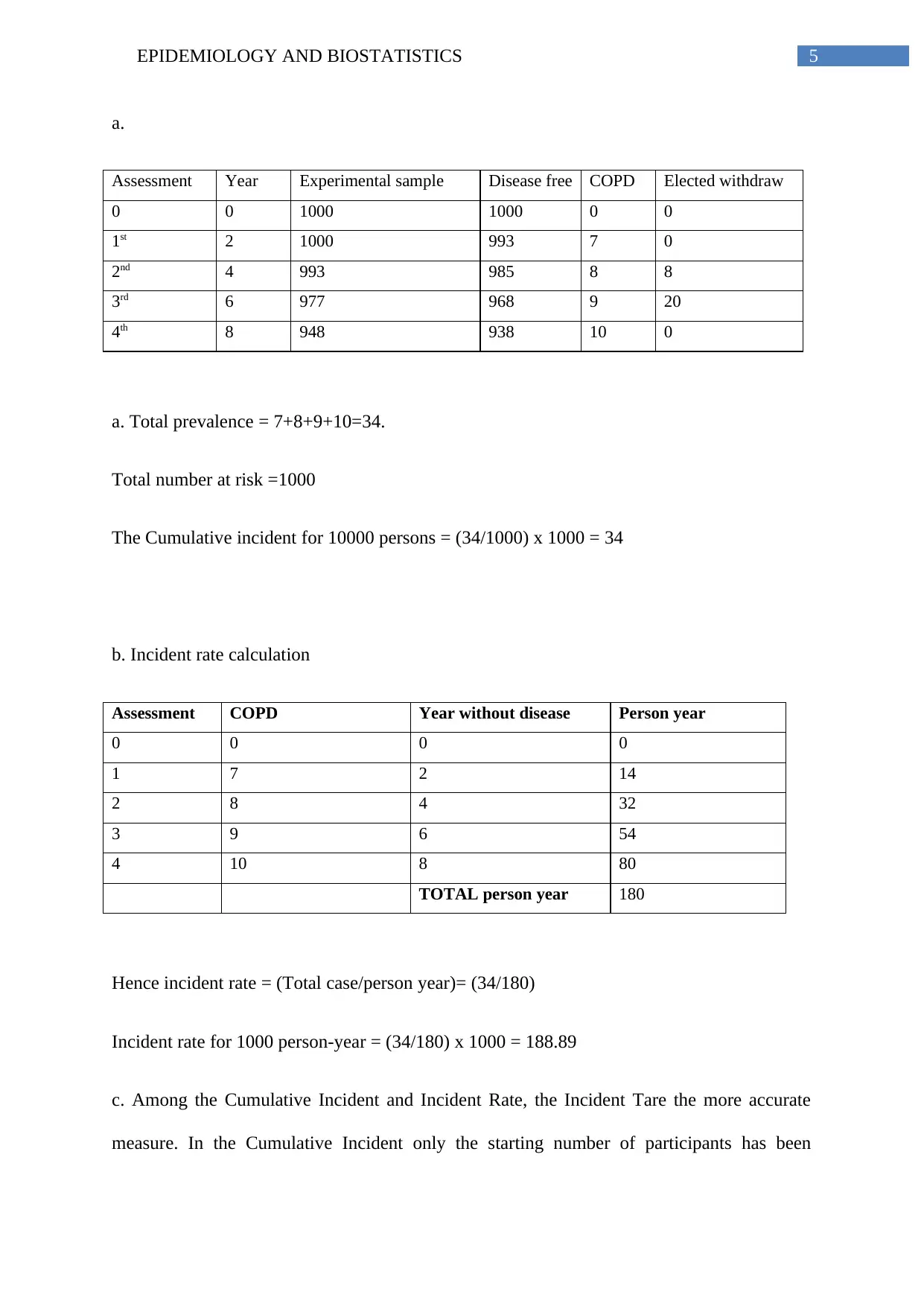
5EPIDEMIOLOGY AND BIOSTATISTICS
a.
Assessment Year Experimental sample Disease free COPD Elected withdraw
0 0 1000 1000 0 0
1st 2 1000 993 7 0
2nd 4 993 985 8 8
3rd 6 977 968 9 20
4th 8 948 938 10 0
a. Total prevalence = 7+8+9+10=34.
Total number at risk =1000
The Cumulative incident for 10000 persons = (34/1000) x 1000 = 34
b. Incident rate calculation
Assessment COPD Year without disease Person year
0 0 0 0
1 7 2 14
2 8 4 32
3 9 6 54
4 10 8 80
TOTAL person year 180
Hence incident rate = (Total case/person year)= (34/180)
Incident rate for 1000 person-year = (34/180) x 1000 = 188.89
c. Among the Cumulative Incident and Incident Rate, the Incident Tare the more accurate
measure. In the Cumulative Incident only the starting number of participants has been
a.
Assessment Year Experimental sample Disease free COPD Elected withdraw
0 0 1000 1000 0 0
1st 2 1000 993 7 0
2nd 4 993 985 8 8
3rd 6 977 968 9 20
4th 8 948 938 10 0
a. Total prevalence = 7+8+9+10=34.
Total number at risk =1000
The Cumulative incident for 10000 persons = (34/1000) x 1000 = 34
b. Incident rate calculation
Assessment COPD Year without disease Person year
0 0 0 0
1 7 2 14
2 8 4 32
3 9 6 54
4 10 8 80
TOTAL person year 180
Hence incident rate = (Total case/person year)= (34/180)
Incident rate for 1000 person-year = (34/180) x 1000 = 188.89
c. Among the Cumulative Incident and Incident Rate, the Incident Tare the more accurate
measure. In the Cumulative Incident only the starting number of participants has been
⊘ This is a preview!⊘
Do you want full access?
Subscribe today to unlock all pages.

Trusted by 1+ million students worldwide
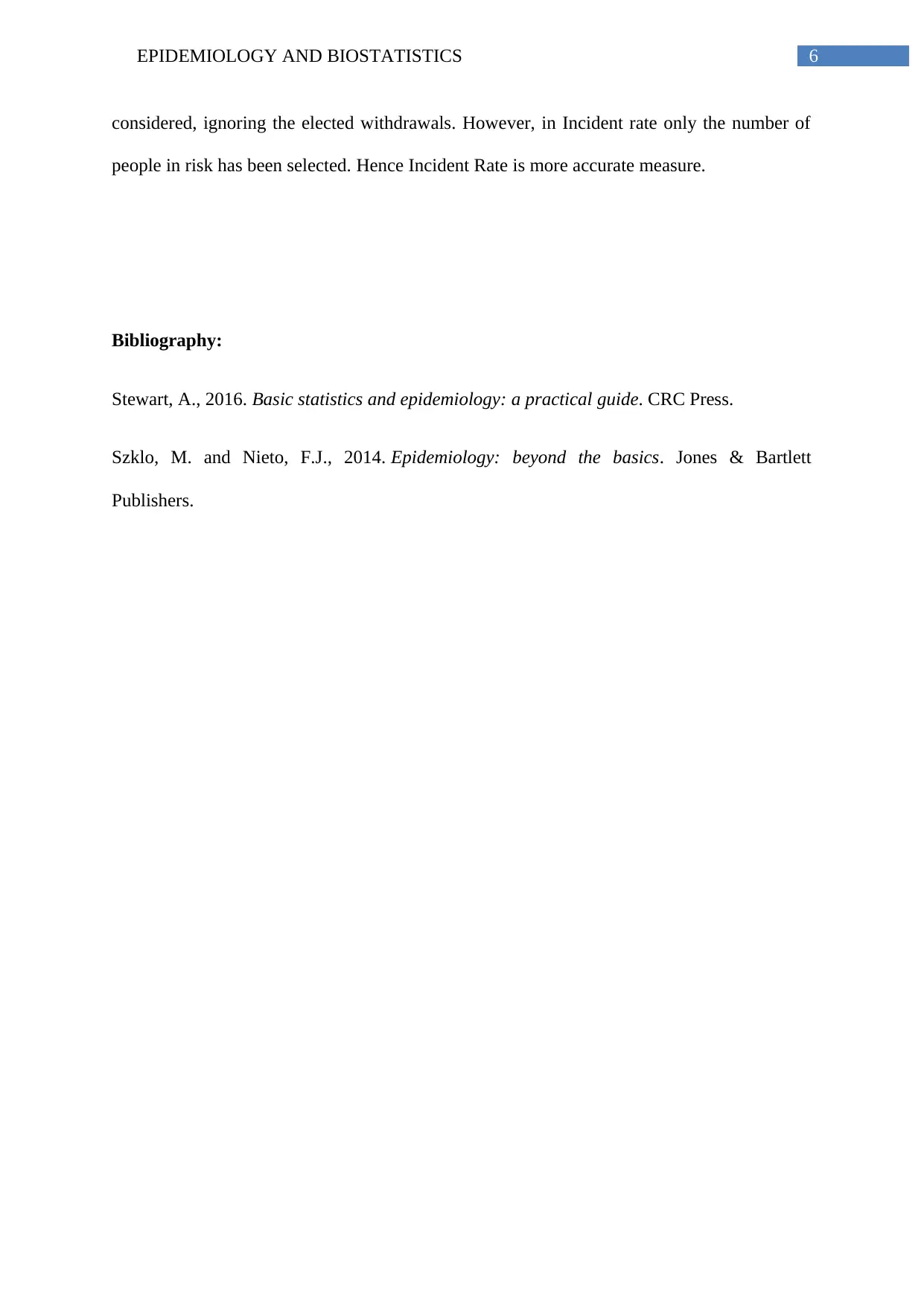
6EPIDEMIOLOGY AND BIOSTATISTICS
considered, ignoring the elected withdrawals. However, in Incident rate only the number of
people in risk has been selected. Hence Incident Rate is more accurate measure.
Bibliography:
Stewart, A., 2016. Basic statistics and epidemiology: a practical guide. CRC Press.
Szklo, M. and Nieto, F.J., 2014. Epidemiology: beyond the basics. Jones & Bartlett
Publishers.
considered, ignoring the elected withdrawals. However, in Incident rate only the number of
people in risk has been selected. Hence Incident Rate is more accurate measure.
Bibliography:
Stewart, A., 2016. Basic statistics and epidemiology: a practical guide. CRC Press.
Szklo, M. and Nieto, F.J., 2014. Epidemiology: beyond the basics. Jones & Bartlett
Publishers.
1 out of 7
Related Documents
Your All-in-One AI-Powered Toolkit for Academic Success.
+13062052269
info@desklib.com
Available 24*7 on WhatsApp / Email
![[object Object]](/_next/static/media/star-bottom.7253800d.svg)
Unlock your academic potential
Copyright © 2020–2026 A2Z Services. All Rights Reserved. Developed and managed by ZUCOL.





